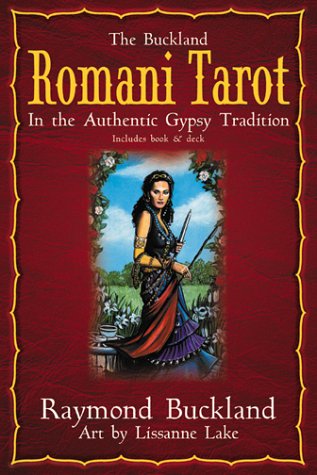
by Raymond Buckland and Lissanne Lake
CW: The author, (who identifies as Romani,) uses the word g*psy throughout the guidebook, which was published 20 years ago.
Preface to review: The author has a section detailing the origins of the word g*psy on page 1 of the guidebook after the preface, noting that the correct modern term is Rom, Romana, or Romani.
This is one of my older tarot decks, a deck that was gifted to me by a friend. Since they gave it to me, the original edition (2001) has gone out of print and has become quite rare and expensive, definitely a collector’s edition. It is also one of the most beautiful and interesting decks in my collection, one I enjoy working with for personal readings as well as reading for others.
The cards themselves are brightly colored, on a good thick card stock that feels substantial in the hands, but still shuffles nicely. They’re standard tarot size, so they’re easy to work with, even if you have small hands. They have rounded corners, which makes them feel nice when you’re riffle shuffling, because you don’t catch a sharp corner with your palm.
The art is by Lisanne Lake, an established illustrator of New Age, sci-fi, and fantasy projects. The author notes that this deck was created collaboratively, much like the collaboration between A.E. Waite and Pamela Coleman-Smith (except, of course, that Lake’s attribution to the deck is more readily apparent that Colemna-Smith’s, but that’s a debate for another day.)
Like other Buckland books and decks, the guide book is substantial, around 225+ pages, with meticulous detail. Many cards follow traditional RWS imagery, with certain deviations from the norm which make the deck unique. For example, the Magician is represented as female in this deck, as the author notes that in English Romani culture, the practitioners of magic (shuv’hanis) are female.
One of the elements of the deck that I appreciate the most is the inclusion of Romani names for the cards, as well as the suits. The Major arcana is the Boro Lil (big book) and the minor arcana is the Taro Lil (little book). Each card includes the Romani name (in the guidebook, not card face, see below) — for example, The Fool is Kolo in the guide. The suits are Bolers (Wheels, Pentacles), Koros (Cups), Koshes (Wands, Staves), and Chivs (Swords, Knives.) The card backs are the Romani flag, blue sky above, green earth below, with a 16-spoke wagon wheel in the center. The imagery of the cards is roughly WWII era of English Romani, which the author notes as his formative childhood years.
The names of the cards are not on the faces, because the author reasons that since card names are not always indicative of card meanings (take the Death card, for example) there is no reason to put the idea in the head of the querent, and rather instead focus on the symbolism of the images in each card. Cards are instead identified by numbers, so unless you’ve worked extensively with this deck, it’s helpful to keep the guidebook handy. I’ve had this deck for over 15 years and still refer to the guidebook whenever I use it.
The guidebook provides meanings for both upright cards and reversals, noting that card meanings, like readings, are not fixed, and that what is important will reveal itself to the querent and the reader. There are 12 unique spreads, varying from the Keltic Cross to the Romani star, many of which are more advanced than spreads you might find in another tarot deck’s guidebook. This doesn’t make it inaccessible to a novice reader (I was not super advanced when I received this deck) but rather, encourages new readers to not be intimidated by more complex, multi-card spreads. The Romani Star and The Buckland Seven Star are 2 of the spreads that I enjoy the most from this deck.
Finally, the end of the book provides tips for card care (I keep mine in a tea tin, they don’t seem to mind), an English-Romani glossary of words, not just for the card names but for the symbolic elements of the cards, as well as a guide to color symbolism, and a bibliography of sources and further reading.